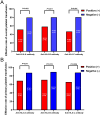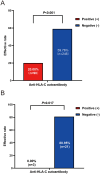Existence and significance of anti-HLA-C autoantibodies to primary and persistent platelet transfusion refractoriness in patients with hematologic disorders: a retrospective study from a single centre
- PMID: 39731480
- PMCID: PMC11703460
- DOI: 10.1080/07853890.2024.2446689
Existence and significance of anti-HLA-C autoantibodies to primary and persistent platelet transfusion refractoriness in patients with hematologic disorders: a retrospective study from a single centre
Abstract
Objectives: Platelet transfusion refractoriness (PTR) is a frustrating clinical problem, and primary and persistent (P/P) PTR who experienced persistent PTR since the first transfusion was failed to be well recognized. This study aims to investigate the incidence and risk factors for P/P PTR.
Methods: Patients with hematologic disorders who underwent HLA high-resolution genotyping and donor-specific HLA antibody or panel reactive antibody (PRA) testing between January 2019 and March 2023 were reviewed. Clinical data including infection history, splenomegaly, frequency and quantity of blood transfusions, and transfusions response were delineated and subsequently analyzed.
Results: 114 patients were included retrospectively, and 1071 transfusions were recorded. The overall incidence of PTR was 28.95% (33/114), with 63.63% (21/33) being P/P PTR. Anti class I HLA (anti-HLA-I) antibody was identified as an independent risk factor for ineffective platelet transfusion through multivariate logistic regression analysis (p = .034). Interestingly, anti-HLA-C autoantibodies were first found in six patients, and both anti-HLA-A and C autoantibodies were detected in one case, comprising a total of 10.71% (6/56) of HLA-I antibody-positive patients. Further analysis revealed that anti-HLA-C autoantibody was identified as an independent risk factor for P/P PTR (p = .039). Among patients with positive anti-HLA-C antibodies, significant differences in the effectiveness of ABO, D-matched and cross-matching transfusions were observed between patients with or without anti-HLA-C autoantibodies (p < .001 and p = .017). Notably, platelet transfusions independence was achieved by two of the four patients who received rituximab.
Conclusions: This work emphasized the significance of anti-HLA-C autoantibody for P/P PTR in hematological patients, and rituximab may therapeutic.
Keywords: Platelet transfusion refractoriness; anti-HLA antibody; anti-HLA-C autoantibody; hematologic disorders.
Plain language summary
28.95% who experienced platelet transfusion refractoriness (PTR), were primary and persistent (P/P) PTRAnti-HLA-C autoantibody was identified as an independent risk factor for P/P PTRApplication of rituximab may practical in the management of P/P PTR with HLA-C autoantibodies.
Conflict of interest statement
No potential conflict of interest was reported by the author(s).
Figures



Similar articles
-
Exploration of risk factors of platelet transfusion refractoriness and its impact on the prognosis of hematopoietic stem cell transplantation: a retrospective study of patients with hematological diseases.Platelets. 2023 Dec;34(1):2229905. doi: 10.1080/09537104.2023.2229905. Platelets. 2023. PMID: 37409458 Review.
-
Exploration of HLA-matched platelet units in HLA-immunized PTR: A retrospective study of patients with hematological disorders.Transfus Clin Biol. 2025 Feb;32(1):56-61. doi: 10.1016/j.tracli.2024.11.008. Epub 2024 Nov 26. Transfus Clin Biol. 2025. PMID: 39608597
-
[Analysis of transfusion effect of different platelet matching schemes in patients with platelet transfusion refractoriness].Zhonghua Yi Xue Za Zhi. 2024 Mar 19;104(11):865-869. doi: 10.3760/cma.j.cn112137-20231204-01281. Zhonghua Yi Xue Za Zhi. 2024. PMID: 38462363 Chinese.
-
A possible role for the production of multiple HLA antibodies in fatal platelet transfusion refractoriness after peripheral blood progenitor cell transplantation from the mother in a patient with relapsed leukemia.Transfusion. 2007 Feb;47(2):326-34. doi: 10.1111/j.1537-2995.2007.01109.x. Transfusion. 2007. PMID: 17302780
-
Prevention and management of platelet transfusion refractoriness.Vox Sang. 1999;76(1):1-13. doi: 10.1159/000031013. Vox Sang. 1999. PMID: 9933848 Review.
References
-
- Song X, Qi J, Li X, et al. . Exploration of risk factors of platelet transfusion refractoriness and its impact on the prognosis of hematopoietic stem cell transplantation: a retrospective study of patients with hematological diseases. Platelets. 2023;34(1):2229905. doi: 10.1080/09537104.2023.2229905. - DOI - PubMed
MeSH terms
Substances
LinkOut - more resources
Full Text Sources
Other Literature Sources
Medical
Research Materials
Miscellaneous
